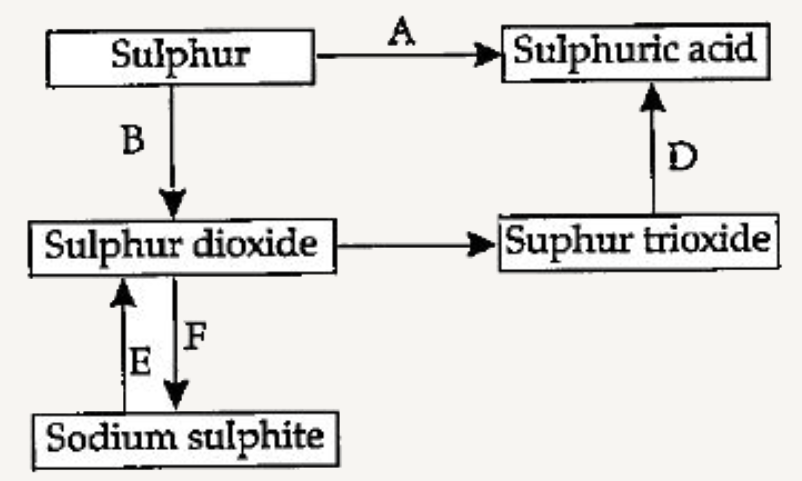Complete Solutions to SECTION II of chapter SELF ASSESSMENT PAPER 05 of Class 10 book with complete answers and questions
| Class 10 | CHEMISTRY |
| Chapter | SELF ASSESSMENT PAPER 05 |
| OSWAL | SECTION II |
| Number Of Questions | 41 |
| Academic Year | 2023-24 |
Name the catalyst which helps in the conversion of sulphur dioxide to sulphur trioxide in step C.
View SolutionIn the Contact process , sulphur trioxide is not converted to sulphuric acid by reacting it with water. A two - step procedure is used Write the equations for the two steps involved.
View Solution
Name the substance produced when sodium sulphite is treated with `H_2SO_4 and HCl` ?
View SolutionWrite the equation for the reaction where sulphur dioxide is converted to sodium sulphite in step F.
View Solution
Name the process used in A.
View Solution
What is the reaction involved in B?
View SolutionState anyone use of aqua regia.
View SolutionWhat is the function of HCl in the preparation of Aqua regia?
View SolutionIdentify the gas evolved and give the chemical test in each of the following cases :
(i) Dilute hydrochloric acid reacts with sodium sulphite.
(ii) Dilute hydrochloric acid reacts with iron (II) sulphide.
View SolutionIdentify the gas evolved and give the chemical test in each of the following cases :
(i) Dilute hydrochloric acid reacts with sodium sulphite.
(ii) Dilute hydrochloric acid reacts with iron (II) sulphide.
View SolutionSodium hydroxide solution is added to the solutions containing the ions mentioned in List X. Use Y gives the details of the precipitate. Match the ions with their coloured precipitates.

View SolutionElectrolysis is used in the purification of metals. Name the following with reference to the electro refining of copper.
Anode and Cathode used.
View SolutionElectrolysis is used in the purification of metals. Name the following with reference to the electro refining of copper.
Electrolyte used.
View SolutionElectrolysis is used in the purification of metals. Name the following with reference to the electro refining of copper.
The product formed at anode and cathode.
View SolutionDetermine the empirical formula of a compound containing Nitrogen = 87.5% and Hydrogen = 12.5%. If the molecular mass is 32. Find its molecular formula.
View SolutionComplete the blanksa] to to e] in the passage given , using the following words .[Ammonium ,reddish brown,hydroxyl,nitrogen dioxide ,ammonia ,dirty green alkaline , acidic].In the presence of a catalyst , nitrogen & hydrogen combine to give a] ______ gas. When the same gasispassed through water ,it formsa soln ,which will be b]______ in nature & will contain the ions c ]____& d]____.e]A ____ coloured ppt . of iron [II] hydroxide is formed when the above soln is added to iron [II] sulphate soln.
View SolutionThe sketch below illustrates the refining of aluminium by Hoope's process.

Which of A and B is the cathode and which one is the anode?
View SolutionThe sketch below illustrates the refining of aluminium by Hoope's process.

What is the electrolyte in the tank?
View SolutionThe sketch below illustrates the refining of aluminium by Hoope's process.

What material is used for the cathode?
View SolutionAnswer the following questions with respect to the electrolytic process in the extraction of aluminium:
For the substance listed below explain the role played in the extraction of aluminium.
Cryolite
View SolutionAnswer the following questions with respect to the electrolytic process in the extraction of aluminium:
For the substance listed below explain the role played in the extraction of aluminium.
Sodium hydroxide
View SolutionAnswer the following questions with respect to the electrolytic process in the extraction of aluminium:
For the substance listed below explain the role played in the extraction of aluminium.
Graphite
View SolutionFollowing questions refer Ostwald's Process of preparing Nitric Acid. Answer the following:
Name the catalyst used.
View SolutionFollowing questions refer Ostwald's Process of preparing Nitric Acid. Answer the following:
Upto which temperature catalyst is heated.
View SolutionFollowing questions refer Ostwald's Process of preparing Nitric Acid. Answer the following:
Give the reaction taking place in the catalyst chamber.
View SolutionFollowing questions refer Ostwald's Process of preparing Nitric Acid. Answer the following:
Name the products formed.
View SolutionThe following questions refer to the periodic table :
Name the second last element of the period 3.
View SolutionHow many elements are there in period 2?
View SolutionThe following questions refer to the periodic table :
Name the element which has the highest electron affinity.
View SolutionThe following questions refer to the periodic table :
Name the element which has the highest electronegativity.
View SolutionThe following questions refer to the periodic table :
Name the element which may be placed in group 1 but is not a metal.
View SolutionWhat is a lone pair?
View SolutionName a neutral covalent molecule which contains lone pair of electrons.
View SolutionDraw an electron dot diagram to show the formation of each of the following compounds :
(i) Methane
(ii) Magnesium Chloride
[H = 1, C = 6, Mg = 12, Cl = 17]
View SolutionDefine:
Atomic size
View SolutionDefine:
Metallic character
View SolutionMethane is prepared in the laboratory by heating a mixture of sodium acetate and______.
View SolutionState the laboratory method for the production of the methane gas.
View SolutionCan you prepare methane from aluminium carbide? If so, give equation.
View SolutionWhat do you know about the solubility of methane in water?
View SolutionWhy direct iodination of methane is not carried? Then how is it carried?
View Solution
SECTION II questions and complete solutions for chapter SELF ASSESSMENT PAPER 05 of EVERGREEN CHEMISTRY (ENGLISH) of Class 10